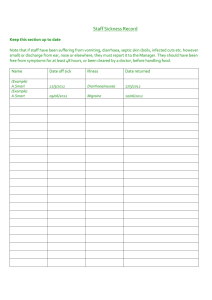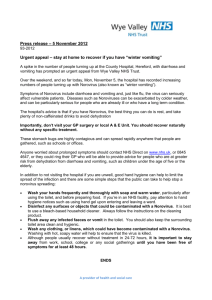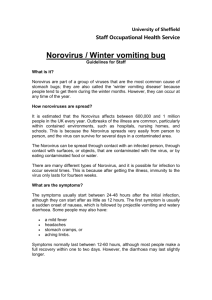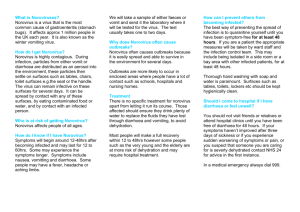Norovirus in a school setting
advertisement
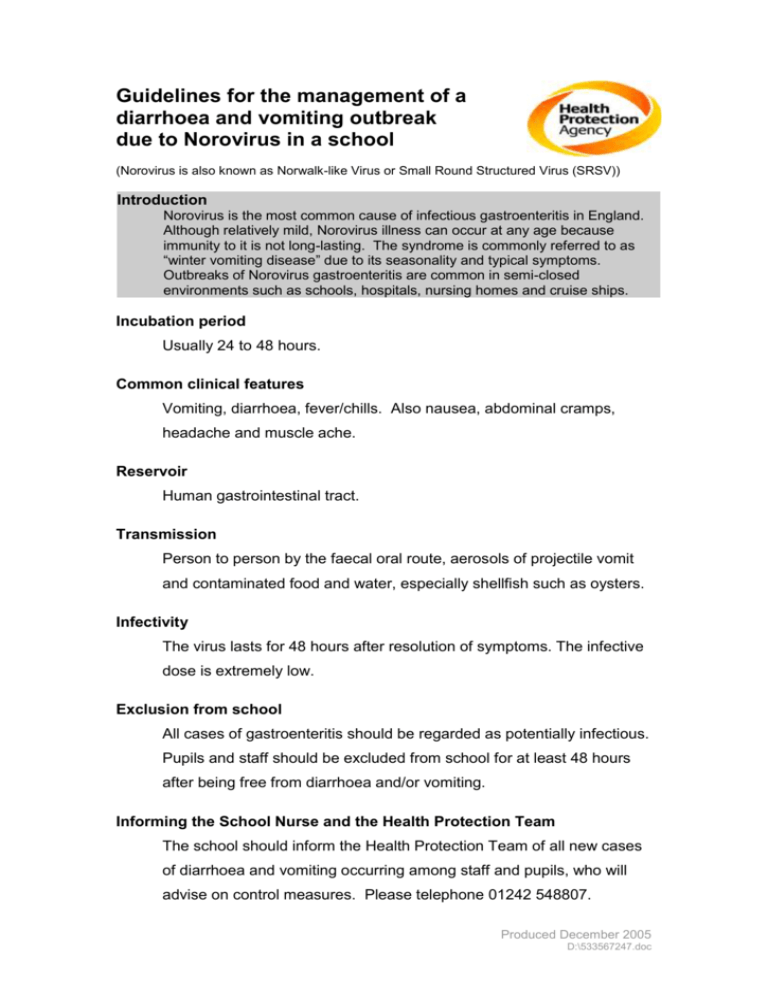
Guidelines for the management of a diarrhoea and vomiting outbreak due to Norovirus in a school (Norovirus is also known as Norwalk-like Virus or Small Round Structured Virus (SRSV)) Introduction Norovirus is the most common cause of infectious gastroenteritis in England. Although relatively mild, Norovirus illness can occur at any age because immunity to it is not long-lasting. The syndrome is commonly referred to as “winter vomiting disease” due to its seasonality and typical symptoms. Outbreaks of Norovirus gastroenteritis are common in semi-closed environments such as schools, hospitals, nursing homes and cruise ships. Incubation period Usually 24 to 48 hours. Common clinical features Vomiting, diarrhoea, fever/chills. Also nausea, abdominal cramps, headache and muscle ache. Reservoir Human gastrointestinal tract. Transmission Person to person by the faecal oral route, aerosols of projectile vomit and contaminated food and water, especially shellfish such as oysters. Infectivity The virus lasts for 48 hours after resolution of symptoms. The infective dose is extremely low. Exclusion from school All cases of gastroenteritis should be regarded as potentially infectious. Pupils and staff should be excluded from school for at least 48 hours after being free from diarrhoea and/or vomiting. Informing the School Nurse and the Health Protection Team The school should inform the Health Protection Team of all new cases of diarrhoea and vomiting occurring among staff and pupils, who will advise on control measures. Please telephone 01242 548807. Produced December 2005 D:\533567247.doc Hygiene, cleaning and disinfection Good standards of hygiene, cleaning and disinfection are important in controlling the spread of the virus, including the following: Hand washing Thorough hand washing with soap (preferably liquid) in warm running water, and drying, is the most important factor in preventing the spread of gastrointestinal infections. Everyone should wash their hands after going to the toilet and before preparing food or eating meals. Schools should be encouraged to use liquid soap and disposable hand towels or air dryers. Cleaning and disinfecting contaminated areas Contamination with faeces, vomit, or urine in the classroom or playground should be cleaned immediately. Absorbent material such as paper towels or tissues may be used to limit the spread of liquid soiling, which should be placed in plastic bags and disposed of straight away. The soiled area, including tables and carpets should be cleaned with hot water and detergent. Vomiting can contaminate an extensive area and care is needed to include all affected areas. After clearing vomit or diarrhoea from carpets it is best to clean the area with a steam cleaner, if available. In the absence of this type of equipment, a thorough cleaning with hot water and detergent will be required. Toilet seats, flush handles, wash-hand basin taps, toilet door handles and surfaces should be cleaned at least daily or more often, depending on use. Hot water and detergent should be used for this purpose. Household bleach (diluted 1:1000 for hard surfaces) is highly effective for cleaning contaminated surfaces that can withstand bleach solutions. Ideally, disposable plastic or rubber gloves and a disposable apron should be worn, and disposable cleaning cloths should be used for cleaning. These may be disposed of by placing in a plastic bag, sealing the neck and placing with solid waste. Hands should be washed thoroughly after cleaning is completed. If household rubber gloves and non-disposable cloths are used for cleaning, these should be washed thoroughly in hot water and detergent after use, rinsed and allowed to dry. References 1) http://www.hpa.org.uk/infections/topics_az/norovirus/menu.htm 2) Preventing person-to-person spread following gastrointestinal infections: guidelines for public health physicians and environmental health officers. Commun Dis Public Health 2004; 7(4): 362-384 3) Management of hospital outbreaks of gastro-enteritis due to small round structured viruses. P. R. Chadwick, G. Beards, D. Brown, E.O. Caul, J. Cheesbrough, I. Clarke, A. Curry, S. O’Brien, K. Quigley J. Sellwood and D.Westmoreland. Journal of Hospital Infection (2000) 45: 1–10 Produced December 2005 D:\533567247.doc


